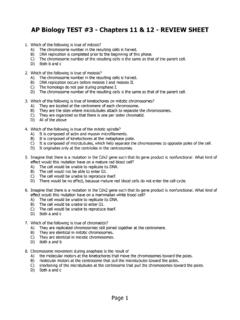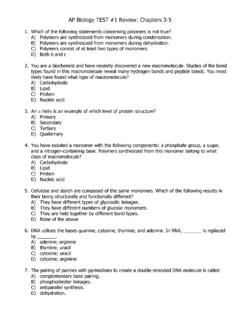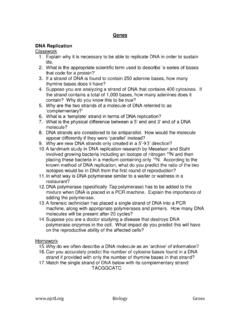Transcription of Lecture 038 - DNA Technology - Goldie's Room
1 Colonie High AP BiologyDeMarco/GoldbergChapter 17 18 Biotechnology:Genomics & DNA Technology Sanger method determine the base sequence of DNA dideoxynucleotides ddATP, ddGTP, ddTTP, ddCTP missing O for bonding of next nucleotide terminates chainDNA SequencingDNA Sequencing Sanger method synthesize complementary DNA strand in vitro in each tube: normal N-bases dideoxy N-bases ddA, ddC, ddG, ddT DNA polymerase primer buffers & salt21342 Fred Sanger1978 | 1980 This was his 2nd Nobel Prize!! 1st was in 1958 for the structure of insulinAdvancements to Sequencing Fluorescent tagging no more radioactivity all 4 bases in 1 lane each base a different color Automated readingAdvancements to Sequencing Fluorescent tagging sequence data Computer read & analyzedColonie High AP BiologyDeMarco/GoldbergRaw Genome DataAutomated Sequencing Machines Really BIG labs!Human Genome Project government project begun in 1990 estimated to be a 15 year project DOE & NIH initiated by Jim Watson led by Francis Collins goal was to sequence entire human genome 3 billion base pairs Celera Genomics Craig Venterchallenged gov t would do it faster, cheaper private companyDifferent Approaches3.
2 Assemble DNA sequence using overlapping sequences. map-based method gov t method shotgun method Craig Venter s method1. Cut DNA from entire chromosome into small fragments and Sequence each segment & arrange based on overlapping nucleotide chromosomal DNA segment into fragments, arrange based on overlapping nucleotide sequences, and clone Cut and clone into smaller Genome ProjectOn June 26, 2001, HGP published the working draft of the DNA sequence of the human Event! blueprint of a human the potential to change science & medicineHow does our genome stack up?OrganismGenome Size (bases)Estimated GenesHuman (Homo sapiens)3 billion30,000 Laboratory mouse (M. musculus) billion30,000 Mustard weed (A. thaliana)100 million25,000 Roundworm (C. elegans)97 million19,000 Fruit fly (D. melanogaster)137 million13,000 Yeast (S. cerevisiae) million6,000 Bacterium (E. coli) million3,200 Human Immunodeficiency Virus (HIV)97009 Colonie High AP BiologyDeMarco/GoldbergGenBankDatabase of genetic sequences gathered from researchPublicly available!
3 Organizing the DataAnd we didn t stop Repetitive DNA Repetitive DNA is spread throughout genome interspersed repetitive DNA (SINEs Short INterspersedElements) make up 25-40% of mammalian genome in humans, at least 5% of genome is made of a family of similar sequences called, Aluelements(PV92 anyone?!) 300 bases long Aluis an example of a "jumping gene " called a transposon; a DNA sequence that "reproduces" by copying itself & inserting into new chromosome locationsRearrangements in the Genome Transposons transposable genetic element piece of DNA that can move from one location to another in cell s genomeOne gene of an insertion sequence codes for transposase, which catalyzes the transposon smovement. The inverted repeats, about 20 to 40 nucleotide pairs long, are backward, upside-down versions of each other. In transposition, transposasemolecules bind to the inverted repeats & catalyze the cutting & resealing of DNA required for insertion of the transposonat a target of transposon sequence in new position in genomeInsertion sequences cause mutations when they happen to land within the coding sequence of a gene or within a DNA region that regulates gene High AP BiologyDeMarco/GoldbergTransposons Barbara McClintock discovered 1st transposonsin Zeamays(corn) in 19471947 | 1983 Retrotransposons Transposonsactually make up over 50% of the corn (maize) genome & 10% of the human genome.
4 Most of these transposonsare retrotransposons, transposable elements that move within a genome by means of RNA intermediate, transcript of the of Genes Human globin gene family evolved from duplication of common ancestral globin geneDifferent versions are expressed at different times in development allowing hemoglobin to function throughout life of developing animal HemoglobinDifferential expression of different beta globingenes ensures important physiological changes during human BIG How can we use our knowledge of DNA to: diagnose disease or genetic defect? cure disease or genetic defect? change/improve organisms? What are the techniques & applications of biotechnology? directmanipulation of genes for practical purposesColonie High AP BiologyDeMarco/GoldbergBiotechnology Genetic manipulation of organisms is notnew humans have been doing this for thousands of years plant & animal breedingEvolution & Breeding of Food PlantsEvolution of Zeamaysfrom ancestral teosinte(left) to modern corn (right).
5 The middle figure shows possible hybrids of teosinte& early corn varietiesartificial selection!Evolution & Breeding of Food Plants Descendants of the wild mustard Brassicagenusartificial selection!Animal Husbandry / Breedingartificial selection!Biotechnology Today Genetic Engineering directmanipulation of DNA if you are going to engineer DNA & genes & organisms, then you need a set of toolsto work with this unit is a survey of those tool Tool Kit Basic Tools restriction enzymes ligase plasmids for gene cloning gel electrophoresis Advanced Tools PCR DNA sequencing Southern blotting DNA libraries / probes microarraysColonie High AP BiologyDeMarco/GoldbergCut, Paste, Copy, Word processing cut (Ctrl + X) restriction enzymes paste (Ctrl + V) ligase copy (Ctrl + C) via plasmids bacteria transformation via PCR find (Ctrl + F) Southern blotting probesCutting DNA Restriction enzymes restriction endonucleases discovered in 1960s evolved in bacteria to cut up foreign DNA ( action restrictedto foreign DNA )
6 Protection against viruses & other bacteria bacteria protect their own DNA by methylation& by notusing the base sequences recognized by the enzymes in their own DNAP aste DNA Sticky ends allow: H bonds between complementary bases to anneal Ligase enzyme seals strands bonds sugar-phosphate bonds covalent bond of DNA backboneAATTCAATTCAATTCGAATTCGGGGGGAATTC CTTAAGGAATTCCTTAAGCTTAACTTAACTTAAGDNA ligasejoins the ends (complementarysingle-stranded DNA tails)Recombinant DNA moleculeBiotech Use of Restriction EnzymesRestriction enzymecuts the DNAAdd DNA from another source cut with same restriction enzymeApplication of Recombinant DNA Combining sequences of DNA from 2 different sources into 1 DNA molecule often from different species human insulin gene in E.
7 Coli (humulin) frost resistant gene from Arctic fish in strawberries Roundup-ready bacterial gene in soybeans BT bacterial gene in corn jellyfish glow gene in Zebra Glofish GFP!Development of GFP Shimomura, Chalfie, Tsien discovery, isolation, and purification of GFP and many fluorescent analogs1961, 1994 | 2008 Osamu ShimomuraMartin ChalfieRoger TsienColonie High AP BiologyDeMarco/GoldbergCut, Paste, Copy, Word processing cut restriction enzymes paste ligase copy plasmids bacteria transformation PCR (chapter 11) find Southern blotting probes Plasmids Plasmids Plasmids small supplemental circles of DNA 5000 -20,000 base pairs self-replicating carry extra genes 2-30 genes can be exchanged between bacteria bacterial sex !! rapid evolution antibiotic resistance can be imported from environmentTransformation Bacteria are opportunists pick up naked foreign DNA wherever it may be hanging out have surface transport proteins that are specialized for the uptake of naked DNA import bits of chromosomes from other bacteria incorporate the DNA bits into their own chromosome express new gene form of recombinationSwapping DNA Genetic recombination by trading DNA132arg+trp-arg-trp+minimalmediaPlasmi ds & Antibiotic Resistance Resistance is futile?
8 1strecognized in 1950s in Japan bacterial dysentery not responding to antibiotics worldwide problem now resistant genes are on plasmids that are swapped between bacteriaColonie High AP BiologyDeMarco/GoldbergCopy DNA Plasmids small, self-replicating circular DNA molecules insert DNA sequence into plasmid vector= vehicle into organism transformation insert recombinantplasmid into bacteria bacteria make lots of copies of plasmid grow recombinant bacteria on agar plate clone of cells = lots of bacteria production of many copies of inserted geneDNA RNA protein traitBiotechnology Used to insert new genes into bacteria example:pUC18 engineered plasmid used in biotechantibiotic resistance gene on plasmid is used as a selective agentBiotechnology Used to insert new genes into bacteria example:pUC18 engineered plasmid used in biotechantibiotic resistance gene on plasmid is used as a selective agentSelection for Plasmid Uptake Ampicillin becomes a selecting agent only bacteria with the plasmid will grow on ampplateLB/amp plateLB plateall bacteria growonly transformed bacteria growRecombinant Plasmid Antibiotic resistance genes as a selectable marker Restriction sites for splicing in gene of interestSelectable marker Plasmid has both added gene & antibiotic resistance gene If bacteria don tpick up plasmid then die on antibiotic plates If bacteria pick up plasmid then survive on antibiotic plates selecting for successful transformationselectionGFPGene Cloning












